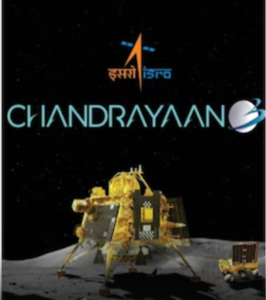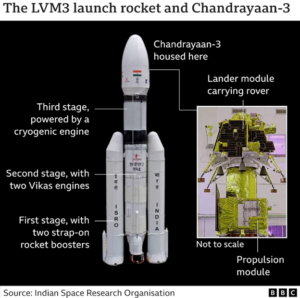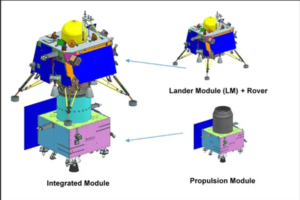To The Moon and Forward.
Relevance
- GS Paper 3: Science and Technology- developments.
- Achievements of Indians in science and technology; indigenization of technology and developing new technology.
- Awareness in the fields of Space.
- Tags: #upsc #chandrayan3 #ISRO #indiaonmoon #IE
Why in the News?
- India has now become the fourth nation to soft land on moon and the first to soft land on the south pole of moon.
Exploring New Frontiers
- ISRO’s successful landing on the Moon marks a significant milestone, ushering in a new phase of lunar exploration. This phase involves multifaceted efforts to comprehend the lunar surface, atmosphere, and the hidden layers beneath.
- While answering questions about Earth’s oceans and surface is relatively simpler, the Moon presents far greater challenges due to the complexity of its space environment.
Unveiling the Unknown
- The ongoing lunar missions focus not only on resource utilization and extraction but also on unraveling the Moon’s mysteries.
- To achieve successful resource extraction, India must delve into a range of variables, such as the elemental composition of the surface, soil strength, and the power requirements for excavation tools.
- These preliminary studies lay the groundwork for future endeavors, which other countries will also contribute to.
Building Knowledge
- Although the world have visited the Moon multiple times, our understanding remains incomplete. Crucial questions about its formation, evolution, and even the abundance of water molecules and other elements persist. These uncertainties necessitate meticulous measurements across several lunar missions.
An Equal Playing Field
- The current round of lunar exploration offers a level playing field for all nations involved. Previous Moon landings in the 1960s and 1970s have not conferred a lasting advantage. This is evident in recent setbacks like Luna-25.
- Even countries with robust space programs, such as the US, are treading cautiously in their lunar pursuits. ISRO stands poised to join this global effort on equal footing.
- India has now become the fourth nation to achieve this remarkable feat. However, it is noteworthy that India is the sole spacefaring nation to explore the challenging and less-understood regions of the Moon, showcasing its scientific audacity and prowess.
Capitalizing on Opportunity
- ISRO’s strategic timing and positioning present a golden opportunity to strengthen its space capabilities. By maximizing this moment, ISRO can enhance its profile as a major space agency.
- Chandrayaan-3’s success coincides with Prime Minister Narendra Modi’s participation in the BRICS summit in Johannesburg. This achievement is poised to enhance India’s profile among BRICS nations, further solidifying its role as an economically and technologically capable partner.
Collaborative Endeavors
- ISRO’s trajectory is veering towards more collaborative missions, a promising development. Collaborative efforts with NASA, such as the Artemis program and joint lunar missions, showcase ISRO’s growing global role.
- As ISRO embraces such partnerships, space exploration becomes more efficient and economical, fostering a mutually beneficial ecosystem.
Embracing Change
- The evolving space sector, including the involvement of private players, signals a transformative shift.
- While traditional satellite launches persist, the emphasis is shifting towards intricate planning and execution of ambitious scientific and planetary exploration missions.
- This shift aligns with ISRO’s role in facilitating and supporting budding private ventures.
Building a Bright Future
- The synergy between ISRO and emerging players promises a robust and vibrant space ecosystem. These collaborative efforts, based on shared strengths, create an exciting chapter in India’s space journey. These are indeed thrilling times for India’s space sector as it embarks on a path of discovery and progress.
- Chandrayaan-3’s journey holds lessons for India’s development strategy. This triumphant moment underscores the importance of perseverance, innovation, and the pursuit of excellence as key drivers for a nation’s progress.
India’s early emphasis on scientific and technological excellence, as exemplified by the establishment of institutions like the Atomic Energy Commission and the Indian Space Research Organization, has culminated in Chandrayaan-3’s success. These visionary decisions laid the groundwork for India’s advancements in science and technology.
| Chandrayaan-3
Mission Objectives of Chandrayaan-3: · To demonstrate Safe and Soft Landing on Lunar Surface; · To demonstrate rover roving on the moon and; · To conduct in-situ scientific experiments. · It consists of an indigenous Lander module (LM), Propulsion module (PM) and a Rover with an objective of developing and demonstrating new technologies required for Inter planetary missions. Features · The payloads on the Vikram lander and rover Pragyan are the same as those used in the Chandrayaan-2 mission. · These scientific payloads on the lander are geared towards studying various aspects of the lunar environment.
The key goals of these payloads include: · Investigating lunar quakes to understand seismic activity on the Moon. · Analyzing the thermal properties of the lunar surface to gain insights into its temperature variations. ·Monitoring changes in plasma around the lunar surface, helping to better comprehend the Moon’s interaction with the space environment. ·Precisely measuring the distance between the Earth and the Moon, contributing to accurate astronomical calculations and space exploration endeavors. |
Sources: ISRO, Indian Express, The Hindu.
Mains Question
“Discuss the significance of ISRO’s recent achievement in successfully landing on the Moon with Chandrayaan 3. How does this accomplishment mark a new phase in lunar exploration and understanding? 250words.






